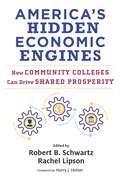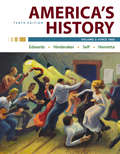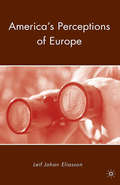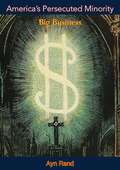- Table View
- List View
America’s First Vaccination: The Controversy of 1721-22 (Routledge Advances in American History)
by Barbara HeifferonThis book explores the response to a new scientific advance in medicine three hundred years ago to understand how this discourse revealed religious, racial, anti-intellectual, and other ideologies the first time documented vaccinations were introduced in America. This text serves as a case study that examines the historic discourses surrounding the implementation of a new prevention technique, smallpox inoculation, to prevent the devastating epidemics of smallpox that had visited the new colonies since their start on the American continent. Using this detailed analysis of the arguments surrounding the project in early America, the author examines the various arguments that circulated in the 1720s regarding the project. When compared to today’s pandemic, this study argues that Americans over-react and complicate scientific applications not with logical scientific perspectives or even with ethical views, but instead bring exaggerated claims founded on uniquely American historical, religious, racial, territorial, and political ideologies. America’s First Vaccination will be of interest to anyone interested in American history, the history of medicine, cultural studies, and a comparison to current pandemic events.
America’s Forgotten Holiday: May Day and Nationalism, 1867-1960 (American History and Culture #2)
by Donna T Haverty-StackeThough now a largely forgotten holiday in the United States, May Day was founded here in 1886 by an energized labor movement as a part of its struggle for the eight-hour day. In ensuing years, May Day took on new meaning, and by the early 1900s had become an annual rallying point for anarchists, socialists, and communists around the world. Yet American workers and radicals also used May Day to advance alternative definitions of what it meant to be an American and what America should be as a nation.Mining contemporary newspapers, party and union records, oral histories, photographs, and rare film footage, America’s Forgotten Holiday explains how May Days celebrants, through their colorful parades and mass meetings, both contributed to the construction of their own radical American identities and publicized alternative social and political models for the nation.This fascinating story of May Day in America reveals how many contours of American nationalism developed in dialogue with political radicals and workers, and uncovers the cultural history of those who considered themselves both patriotic and dissenting Americans.
America’s Geoheritage II: Identifying, Developing, and Preserving America’s Natural Legacy: Proceedings of a Workshop
by Board on International Scientific Organizations Policy and Global Affairs National Academies of Sciences, Engineering, and Medicine Planning Committee for America's Geoheritage II: Identifying, Developing, and Preserving America's Natural LegacyAmerica is endowed with places that embody a rich geoheritage, from sites where indigenous people subsisted for millennia, to mines that furnished the raw materials that built U.S. industry, to mountain ranges and river gorges with unparalleled recreational opportunities, to field sites where students can truly understand a geological process, to places of aesthetic or spiritual value, and many more across all states and territories. In order to assess the status of geoheritage and the activities of its practitioners in the United States in light of social, political, and environmental changes over the past ten years, the National Academies of Sciences Engineering and Medicine convened a series of virtual webinars and a workshop. From September to December 2020, a Distinguished Speakers Webinar Program composed of eight webinars provided an overview of geoheritage initiatives, as well as focused presentations on geoheritage related to federal and state lands, cultural heritage, education, research, and economic development and geotourism. In January 2021, 101 land managers, state geologists, educators, researchers, and members and staff of professional societies and nongovernmental organizations participated in a virtual writing workshop to aggregate and organize community input on strategies and best practices in developing geoheritage sites across the United States. The participants were divided into focus groups that roughly aligned with the topics explored in the fall 2020 workshops. The groups worked synchronously and asynchronously over the course of a week, then presented their ideas in a plenary session. This publication summarizes the presentations and discussion of the webinars and workshop.
America’s Hidden Economic Engines: How Community Colleges Can Drive Shared Prosperity (Work and Learning Series)
by Nancy HoffmanFive in-depth case studies reveal the innovative practices that position U.S. community colleges as pathways to quality employment. In America&’s Hidden Economic Engines, editors Robert B. Schwartz and Rachel Lipson spotlight community and technical colleges as institutions uniquely equipped to foster more equitable economic growth across America&’s regions. As Schwartz and Lipson show, these colleges are the best-placed institutions to reverse the decades-long rise in US economic inequality by race, class, and geography. In the book, Harvard Project on Workforce researchers introduce detailed case studies of five institutions—Lorain County Community College in Ohio, Mississippi Gulf Coast Community College, Northern Virginia Community College, Pima Community College in Arizona, and San Jacinto Community College in Texas—that show what is possible when governments, employers, and communities invest in their community colleges&’ economic and workforce development mission. These case studies reveal key institutional policies and practices, leadership behaviors, and organizational structures of successful collaborations between colleges and their regional partners in the public and private sector. Each case underscores how, although community colleges face distinct challenges based on local context, successful schools demonstrate a consistent focus on economic mobility and good jobs across all their programs and activities. In a concluding chapter, the editors champion community colleges as the most critical institutions for the future of US workforce development policy.
America’s History
by James A. Henretta Rebecca Edwards Robert O. Self Eric HinderakerKnown for its clear, insightful analytical narrative and balanced approach, America's History brings America's diverse past to life. An accessible and balanced narrative with built-in primary sources and skills-based pedagogy gives students practice in thinking historically.
America’s History
by James A. Henretta Rebecca Edwards Robert O. Self Eric HinderakerKnown for its interpretive voice and thoughtful analysis, America's History models exactly the kind of thinking and writing students need to be successful. An accessible and balanced narrative with built-in primary sources and skills-based pedagogy gives students practice in thinking historically, and features new ways of mastering the content so that students come to class prepared. The eighth edition rolls out Bedford/St. Martin's new digital history tools, including LearningCurve, an adaptive quizzing engine that garners over a 90% student satisfaction rate, and LaunchPad, the all new interactive e-book and course space that puts high quality easy-to-use assessment at your fingertips. Easy to integrate into your campus LMS, and featuring video, additional primary sources, a wealth of adaptive and summative quizzing, and more, LaunchPad cements student understanding of the text while helping them make progress toward learning outcomes. It's the best content joined up with the best technology. What's in the LaunchPad
America’s History
by James A. Henretta Rebecca Edwards Robert O. Self Eric HinderakerPraised for its focus on turning points and engines of change, the Concise Edition of America’s History explains the why behind events. The tenth edition presents a greater variety of tools to engage today's students. This edition includes new part opener features to help students study change and continuity in key periods, new coverage of capitalism and the economy, and an enhanced primary and secondary source program designed to develop historical thinking skills.
America’s History for the AP® Course: For the AP® Course
by Rebecca Edwards Eric Hinderaker James Henretta Robert SelfHistory classrooms present a unique dilemma. How do we offer our students a basic understanding of key events and facts while inviting them to see the past not as a rote list of names and dates but as the fascinating, conflicted prelude to their lives today? How do we teach our students to think like historians? As scholars and teachers who go into the classroom every day, the authors of America’s History know these challenges well. We have composed the ninth edition to help instructors meet them. America’s History has long been known for its breadth, balance, and ability to explain to students not just what happened, but why. The latest edition preserves and builds on those strengths.
America’s History, Concise Edition
by James A. Henretta Rebecca Edwards Robert O. Self Eric HinderakerKnown for its clear, insightful analytical narrative and balanced approach, America's History, Concise Edition is a brief, affordable text that brings America's diverse past to life. The Concise Edition features the full narrative of the parent text, select images and maps, built-in primary sources and skills-based pedagogy that gives students practice in thinking historically. Enhanced with a wealth of digital content in LaunchPad, the ninth edition provides easily assignable options for instructors and novel ways for students to master the content. Integrated with LearningCurve's, an adaptive online resource that helps students retain the material and come to class prepared.
America’s History, Concise Edition, Volume 1
by James A. Henretta Rebecca Edwards Robert O. Self Eric HinderakerKnown for its clear, insightful analytical narrative and balanced approach, America's History, Concise Edition is a brief, affordable text that brings America's diverse past to life. The Concise Edition features the full narrative of the parent text, select images and maps, built-in primary sources and skills-based pedagogy that gives students practice in thinking historically. Enhanced with a wealth of digital content in LaunchPad, the ninth edition provides easily assignable options for instructors and novel ways for students to master the content. Integrated with LearningCurve's, an adaptive online resource that helps students retain the material and come to class prepared.
America’s History, Value Edition
by James A. Henretta Rebecca Edwards Robert O. Self Eric HinderakerKnown for its clear, insightful analytical narrative and balanced approach, America's History, Value Edition is a brief, affordable text that brings America's diverse past to life. The two-color Value Edition includes the full narrative, the popular nine-part organization, and select images and maps.
America’s History, Value Edition, Volume 1
by James A. Henretta Rebecca Edwards Robert O. Self Eric HinderakerKnown for its clear, insightful analytical narrative and balanced approach, America's History, Value Edition is a brief, affordable text that brings America's diverse past to life. The two-color Value Edition includes the full narrative, the popular nine-part organization, and select images and maps. Enhanced with a wealth of digital content in LaunchPad, the ninth edition provides easily assignable options for instructors and novel ways for students to master the content. Integrated with LearningCurve, an adaptive online resource that helps students retain the material and come to class prepared.
America’s History, Value Edition, Volume 2
by James A. Henretta Rebecca Edwards Robert O. Self Eric HinderakerKnown for its interpretive voice, balanced analysis, and brief-yet-comprehensive narrative, America's History, Value Edition helps students to make sense of it all while modeling the kind of thinking and writing they need to be successful. The two-color Value Edition includes the full narrative, the popular nine-part organization, and select images and maps. This new Value Edition introduces a breakthrough in teaching and learning through the addition of LaunchPad, an intuitive e-book and course space with LearningCurve adaptive quizzing. LaunchPad also features all of the contents of the full edition including primary source activities, map and visual activities, adaptive and summative quizzing, and a wealth of optional resources.
America’s History, Volume 2
by James A. Henretta Rebecca Edwards Robert O. Self Eric HinderakerKnown for its interpretive voice, balanced analysis, and brief-yet-comprehensive narrative, America's History, Value Edition helps students to make sense of it all while modeling the kind of thinking and writing they need to be successful. The two-color Value Edition includes the full narrative, the popular nine-part organization, and select images and maps. This new Value Edition introduces a breakthrough in teaching and learning through the addition of LaunchPad, an intuitive e-book and course space with LearningCurve adaptive quizzing. LaunchPad also features all of the contents of the full edition including primary source activities, map and visual activities, adaptive and summative quizzing, and a wealth of optional resources.
America’s History: To 1877
by Rebecca EdwardsPraised for its focus on turning points and engines of change, America’s History explains the why behind events. The tenth edition presents a greater variety of tools to engage today's students. This edition includes new part opener features to help students study change and continuity in key periods, new coverage of capitalism and the economy, and an enhanced primary and secondary source program designed to develop historical thinking skills.
America’s Horror Stories: U.S. History through Dark Tourism (Routledge Studies in Crime, Culture and Media)
by Kevin Revier Favian Alejandro MartínAmerica’s Horror Stories: U.S. History through Dark Tourism conducts a ghost tour(ist) methodology to explore how slavery and racism are represented in dark tourism via ghost tours.The authors travel to key sites of racist U.S. history, including Salem, Massachusetts, where a witch panic was sparked by accusations of witchcraft by Tituba, an enslaved woman practicing Voodoo; New Orleans, Louisiana, which hosts the largest slave trade market; the Myrtles Plantation in Francisville, Louisiana; and to Gettysburg, Pennsylvania, where the bloodiest battle of the Civil War took place, marking a pivotal moment to end slavery in the nation—but where Confederate ghosts are said to continue roaming the town and battlefield. Acting as research ghost hunters/tourists, the authors go on walking and bus tours, visit historical monuments, stay at haunted hotels, ponder objects in haunted museums, and do some ghost hunting of their own. They find that the ghosts conjured by tour guides—ghosts of confederate soldiers, American citizens, and enslaved people—tend to whitewash, sensationalize, and commercialize the horrors of U.S. history, including slavery, racism, and colonialism. They do not discount dark tourism entirely; but recommend a ghost tour(ist) pedagogy that critically considers social issues—and structural forms of inequality—that haunt us today.America’s Horror Stories will be of great interest to students and scholars researching and taking part in critical criminology and cultural criminology courses, specifically on crime, media, and culture.
America’s Last Call: On the Brink of a Financial Holocaust
by David Wilkerson(Quoted from the Author) "A majority of Americans have concluded, 'Morals do not count. Let our leaders do as they please; just give us a booming economy!' God is about to crush this abominable American mindset. Soon the American dream will become the American nightmare. Yet through it all, those who know God can be assured of constant protection and provision from His hands." Even though Wilkerson published his book in 1998, his predictions about the U.S. economy are surprisingly accurate. and therefore, are worth investigating.
America’s Mercenaries: War By Proxy
by Major Kevin G. CollinsAlthough the government's reliance on contractors to support military forces is not a new phenomenon, the degree to which contractors are involved in Operations Enduring Freedom and Iraqi Freedom (OIF) has increased substantially. In OIF in particular, contractors perform a wide range of services in support of stabilization and reconstruction efforts. Perhaps the most controversial and arguably the most troublesome of these contractors are those that are armed and use violence in the course of fulfilling their contractual obligations. This thesis explores whether or not such contractors, herein identified as private security providers (PSPs), have a destabilizing influence on United States political and military objectives. In doing so, the thesis identifies and evaluates the legal environment in which PSPs operate the intersection between PSP activities and critical requirements and vulnerabilities of coalition forces and PSP involvement within logical lines of operation within Iraq. In concluding, the author posits that PSPs have a destabilizing impact on not only the political and military mission, but the United States military as well. Finally, the author provides recommendations for employing PSPs in the present and future conflicts.
America’s Middlemen: Power At The Edge Of Empire
by Eric GrynaviskiThroughout American political history, the US government has formed alliances with militias, tribes, and rebels. Sometimes, these alliances have been successful, dramatically reshaping the battlefield. But these alliances have also risked creating larger wars in regions where the United States had no real interest. <P><P>Understanding these alliances - and much of American political history - requires moving beyond our normal focus on traditional diplomats or social elites. Traders, missionaries, former slaves, and low-level government employees drove these alliances. These intermediaries used their relationships across borders to shape security politics, affecting American and thereby world history. <P>Skillfully integrating political science with history and sociology, Eric Grynaviski provides a novel account of who matters and why in international politics. By developing broader views about political agency - how people come to make a difference in world politics - he brings into focus new histories of world politics and how they matter for scholars and the public.<P> Proposes a new theory of agency in international politics that will resonate in interdisciplinary conversations about agency and politics.<P> Provides fresh and new histories of important events in international politics.<P> Features extensive and innovative use of archival evidence.<P>
America’s Most Famous Catholic: Stephen Colbert and American Religion in the Twenty-First Century (Catholic Practice In North America Ser.)
by Stephanie N. BrehmFor nine years, Stephen Colbert’s persona, “Colbert”—a Republican superhero and parody of conservative political pundits—informed audiences on current events, politics, social issues, and religion while lampooning conservative political policy, biblical literalism, and religious hypocrisy. As devout, vocal, and authoritative lay Catholics, religion is central to both the actor and his most famous character. Yet many viewers wonder, “Is Colbert a practicing Catholic in real life or is this part of his act?” America’s Most Famous Catholic (According to Himself) examines the ways in which Colbert challenges perceptions of Catholicism and Catholic mores through his faith and comedy.Religion and the foibles of religious institutions have served as rich fodder for scores of comedians over the years. What set “Colbert” apart on his Comedy Central show, The Colbert Report, was that his critical observations were made more powerful and harder to ignore because he approached religious material not from the predictable stance of the irreverent secular comedian but from his position as one of the faithful. He is a Catholic celebrity who can bridge critical outsider and participating insider, neither fully reverent nor fully irreverent.Providing a digital media ethnography and rhetorical analysis of Stephen Colbert and his character from 2005 to 2014, author Stephanie N. Brehm examines the intersection between lived religion and mass media, moving from an exploration of how Catholicism shapes Colbert’s life and world toward a conversation about how “Colbert” shapes Catholicism. Brehm provides historical context by discovering how “Colbert” compares to other Catholic figures, such Don Novello, George Carlin, Louis C.K., and Jim Gaffigan, who have each presented their views of Catholicism to Americans through radio, film, and television. The last chapter provides a current glimpse of Colbert on The Late Show, where he continues to be a voice for Catholicism on late night, now to an even broader audience.America’s Most Famous Catholic (According to Himself) also explores how Colbert carved space for Americans who currently define their religious lives through absence, ambivalence, and alternatives. Brehm reflects on the complexity of contemporary American Catholicism as it is lived today in the often-ignored form of Catholic multiplicity: thinking Catholics, cultural Catholics, cafeteria Catholics, and lukewarm Catholics, or what others have called Colbert Catholicism, an emphasis on the joy of religion in concert with the suffering. By examining the humor in religion, Brehm allows us to see clearly the religious elements in the work and life of comedian Stephen Colbert.
America’s New Order
by S. D. JohnsonThis is a fictional story about wealthy entrepreneur, Henry Riley, and his obsessive need to control the United States of America. Backed by his political New Order Party, are members determined to create a new society, a new order for the working class. From his three children, Henry plans to have his eldest son at the helm. Supported by their family’s private firm, NUKE Security, and a privatized U.S. military, by 2037, he will control the U.S. under unlimited unilateral power, enacting new decrees and laws, while using technological advancements to control the American people. Truth is in the fiction.
America’s New Racial Battle Lines: Protect versus Repair (Chicago Studies in American Politics)
by Rogers M. Smith Desmond KingA sobering portrait of the United States’ divided racial politics. For nearly two decades, Rogers M. Smith and Desmond King have charted the shifting racial policy alliances that have shaped American politics across different eras. In America’s New Racial Battle Lines, they show that US racial policy debates are undergoing fundamental change. Disputes over colorblind versus race-conscious policies have given way to new lines of conflict. Today’s conservatives promise to protect traditionalist, predominantly white, Christian Americans against what they call the “radical” Left. Meanwhile, today’s progressives seek not just to integrate American institutions but to more fully transform and “repair” pervasive systemic racism. Drawing on interviews with activists, surveys, social network analyses, and comprehensive reviews of federal, state, and local policies and advocacy groups, Smith and King map the memberships and goals of two rival racial policy alliances and delineate the contrasting stories each side tells. They also show that these increasingly polarized racial policy alliances are substantially funded on both the Left and Right. Placing today’s conflicts in theoretical and historical perspectives, Smith and King analyze where these intensifying clashes may take the nation in the years ahead. They highlight the great potential for mounting violence, as well as the remaining possibilities for finding common ground.
America’s Next Reality Star: Reality Star Book 1
by Laura HeffernanLife after college isn’t as seen on TV: Jen’s low-paying job is uninspiring, her boyfriend won’t commit, and she just got evicted. The most exercise she gets comes from dodging debt collectors. Then she sees aån ad seeking competitors for a new reality show with a $250,000 prize. She desperately needs money and the lottery isn’t looking good, so she applies, never expecting to get the call. Until she does. With nothing to lose, Jen packs a bag and heads for the Hollywood hills to star in The Fishbowl. Most of the contestants want to create drama to gain viewer votes, but Jen is all about the joy of the game. Unfortunately, she becomes embroiled in a love triangle and battling another woman for the attention of a fellow contestant. It’s tricky balancing act to hold onto viewers without lying, cheating, or backstabbing—things that don’t bother her opponents. When Jen discovers that she’s on the verge of elimination, she must decide whether “winning” means sacrificing the money, love, or her sense of self.
America’s Perceptions of Europe
by Leif Johan EliassonThis book seeks to rectify Americans' views of its closest ally, Europe - an ambitious task, but one sorely lacking in the literature. Many prejudices about Europe surface in headlines, while others remain latent, but they are real, pervasive and ingrained.
America’s Persecuted Minority: Big Business
by Ayn RandAmerica’s Persecuted Minority: Big Business was a lecture delivered by Ayn Rand at the Ford Hall Forum, Boston, on December 17, 1961, and at Columbia University on February 15, 1962. Rand argues that “every ugly, brutal aspect of injustice toward racial or religious minorities is being practiced towards businessmen” under America’s antitrust laws. Rand catalogues the injustices of antitrust, decries the scapegoating of businessmen, analyzes particular cases, rejects antitrust laws as non-objective and calls for their ultimate repeal.























